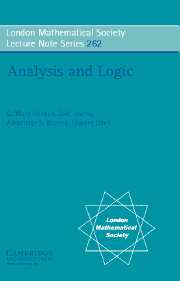Book contents
- Frontmatter
- Contents
- Preface
- Introduction
- Part One: Ultraproducts in Analysis
- 1 Introduction
- 2 Normed Space Structures
- 3 Signatures
- 4 Ultrapowers of Normed Space Structures
- 5 Positive Bounded Formulas
- Basic Model Theory I
- 7 Quantifier-Free Formulas
- 8 Ultraproducts of Normed Space Structures
- 9 Basic Model Theory II
- 10 Isomorphic Ultrapowers
- 11 Alternative Formulations of the Theory
- 12 Homogeneous Structures
- 13 More Model Theory
- 14 Types
- References
- Index of Notation
- Index
- Actions of Polish Groups and Classification Problems
- On Subspaces, Asymptotic Structure, and Distortion of Banach Spaces; Connections with Logic
5 - Positive Bounded Formulas
Published online by Cambridge University Press: 05 May 2013
- Frontmatter
- Contents
- Preface
- Introduction
- Part One: Ultraproducts in Analysis
- 1 Introduction
- 2 Normed Space Structures
- 3 Signatures
- 4 Ultrapowers of Normed Space Structures
- 5 Positive Bounded Formulas
- Basic Model Theory I
- 7 Quantifier-Free Formulas
- 8 Ultraproducts of Normed Space Structures
- 9 Basic Model Theory II
- 10 Isomorphic Ultrapowers
- 11 Alternative Formulations of the Theory
- 12 Homogeneous Structures
- 13 More Model Theory
- 14 Types
- References
- Index of Notation
- Index
- Actions of Polish Groups and Classification Problems
- On Subspaces, Asymptotic Structure, and Distortion of Banach Spaces; Connections with Logic
Summary
In this chapter we introduce the key ingredients of the logic for normed space structures that is described in this paper. These are the positive bounded formulas and the concept of approximate satisfaction of such formulas in normed space structures.
Let L be a signature for a normed space structure ℳ based on (M(s) ∣ s ∈ S). Recall that S has a distinguished element s = Sℝ for which M(s) = ℝ is the sort of real numbers.
We begin considering ℳ from the model theoretic point of view, introducing a formal language based on L and a semantics according to which this language is interpreted in ℳ. In addition to the symbols of the signature L, we also need for each element s of the sort index set S, a countable set of symbols called the variables of sort s.
We begin defining the formal language by introducing the set of terms of L, or L-terms. Each term is a finite string of symbols, each of which may be a variable or a function symbol of L, or one of the symbols (or, which are used for punctuation. In this many-sorted context, each term is associated with a unique sort which indicates its range. The formal definition is recursive.
Definition. An L-term with range of sort s is a string which can be obtained by finitely many applications of the following rules of formation:
If x is a variable of L of sort s, then x is a term with range of sort s.
[…]
- Type
- Chapter
- Information
- Analysis and Logic , pp. 21 - 30Publisher: Cambridge University PressPrint publication year: 2003



